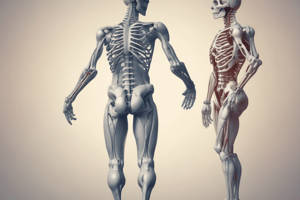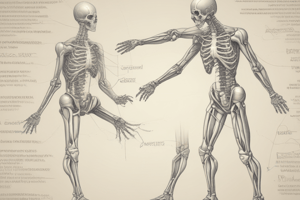Podcast
Questions and Answers
Which microorganisms are commonly associated with minor hand injuries, such as lacerations and puncture wounds?
Which microorganisms are commonly associated with minor hand injuries, such as lacerations and puncture wounds?
- Salmonella & Listeria
- Klebsiella & Pseudomonas
- Escherichia coli & Staphylococcus aureus (correct)
- Clostridium & Bacillus
What is the primary goal in treating infectious conditions like tuberculous osteomyelitis and tuberculous arthritis?
What is the primary goal in treating infectious conditions like tuberculous osteomyelitis and tuberculous arthritis?
- To reduce inflammation
- To manage pain
- To eradicate the infection (correct)
- To promote tissue repair
What is the characteristic feature of granulomatous infections?
What is the characteristic feature of granulomatous infections?
- Inflammation of tissues
- Production of granules (correct)
- Necrosis of tissues
- Formation of abscesses
What is the primary method of diagnosis for congenital conditions?
What is the primary method of diagnosis for congenital conditions?
What is the primary goal of treatment for congenital conditions?
What is the primary goal of treatment for congenital conditions?
What is the primary cause of Spina Bifida?
What is the primary cause of Spina Bifida?
What is the primary treatment for Skeletal Dysplasia?
What is the primary treatment for Skeletal Dysplasia?
What is the primary goal of treatment for Clubfoot?
What is the primary goal of treatment for Clubfoot?
What is the primary method of treatment for granulomatous infections?
What is the primary method of treatment for granulomatous infections?
What is the primary goal of treatment for congenital conditions?
What is the primary goal of treatment for congenital conditions?
Flashcards are hidden until you start studying
Study Notes
Classification of Musculoskeletal Disorders
- Musculoskeletal disorders can be classified into Acquired and Congenital conditions
- Acquired conditions can be further classified into Cumulative, Traumatic, Degenerative, Systemic, Medical, Autoimmune, Genetic, Developmental, Infectious, Neoplasmic, and Chemical disorders
- Congenital conditions can be classified into Localized and Generalized disorders
Musculoskeletal Tissues
- Musculoskeletal tissues can be classified into "Hard" tissues (Bone, Cartilage) and Soft tissues (Muscle, Tendon, Ligament, Synovium, Fascia, Skin, Peripheral Bursa, Vessels, Nerve, Brain, and Spinal Cord)
- Axial and Peripheral musculoskeletal tissues can be affected by disorders
Etiology of Musculoskeletal Disorders
- Musculoskeletal disorders can be caused by Traumatic, Cumulative, Degenerative, Mechanical, or Non-mechanical factors
- Etiology can also be classified into "Hard" tissue vs Soft tissue, Acquired vs Congenital, and Traumatic vs Cumulative/Degenerative disorders
Musculoskeletal and Nervous Systems
- Injuries to musculoskeletal tissues can elicit nociceptive pain
- Injuries to peripheral nerves and central nervous system can elicit neuropathic pain and other manifestations
Traumatic Injury of Bone
- Fractures are a disruption of bone continuity
- Types of fractures include open, close, transverse, oblique, greenstick, spiral, avulsion, intra-articular fractures, etc.
- Management of fractures includes Splintage, Closed reduction, Open reduction, Internal fixation, and External fixation
Traumatic Injury of Soft Tissue
- Torn Tendons (Strain) can cause nociceptive pain
- Nerve Impingement can cause neuropathic pain
- Closed tendon injuries can cause frayed/degenerated tendon
- Open tendon injuries can cause open rupture or cut of the tendon
- Management of torn tendons includes Surgical process, Injection of anti-inflammatory agent, Restriction of activity with splints, and Surgical interventions
Cumulative/Degenerative Conditions
- Osteoarthritis is a degenerative condition initiated by local deterioration of articular cartilage
- It can cause secondary inflammation of the synovial membrane
- Sites commonly affected include weight-bearing synovial joints, such as hip and knee
- Signs and Symptoms include pain, spasm of surrounding muscles, restricted AROM and PROM, and associated crepitus
Inflammation
- Inflammation is a protective response that involves immune cells, blood vessels, and molecular mediators
- Signs and Symptoms of inflammation include Redness, Swelling, Heat, Pain, and Loss of function
- Subtypes of inflammation include specific infections, nonspecific and idiopathic inflammatory types, inflammation caused by chemical irritants, and chronic inflammation caused by repeated physical injury
Infectious Conditions
- Pyogenic infections can cause osteomyelitis, septic arthritis, and tenosynovitis
- Soft tissues are frequently infected by pyogenic bacteria due to high incidence of minor hand injuries
- Management of pyogenic infections includes the concentration of appropriate antibiotics in the blood and at the site of infection
- Granulomatous infections can cause tuberculous osteomyelitis and tuberculous arthritis
- Management of granulomatous infections includes excision and drug treatment
Congenital Conditions
- Congenital conditions can be caused by Genetic defects, Environmental influences, or a combination of both
- Types of congenital conditions include Localized and Generalized disorders
- Diagnosis can be made Antenatally or Postnatally
- Treatments include Therapeutic drugs, Orthopedic apparatus and appliances, OT/PT, Surgical repair and reconstruction, and Electrical stimulation
Studying That Suits You
Use AI to generate personalized quizzes and flashcards to suit your learning preferences.




